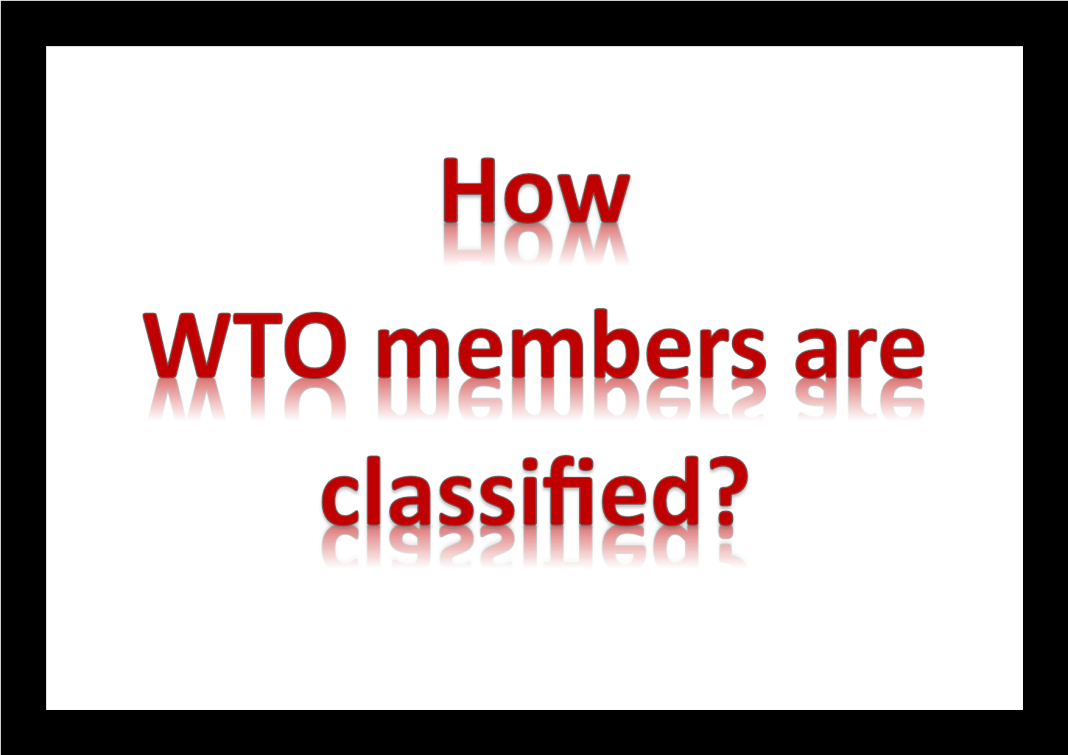
How WTO members are classified?
The WTO with 164 members follows a classification system for member countries that is mainly self-chosen by members. Here, members have to consider their development status. Members can identify and declare whether they belong to developing country or not. All countries that are not developing are categorized as developed countries.
1. Developed Countries and
2. Developing Countries – (i) Least Developed Countries and (ii) Developing Countries.
It is the degree of development of the member countries that presumably determines whether a country belongs to developed or developing. Self-identification by a member either in the developing group or in the developed group is the first step of classification. Then, WTO identifies the Least Developed Countries from the broader developing country group by adopting the UN based per capita income criteria.
How Developing countries are designated?
An interesting aspect of WTO’s approach with regard to the classification of member countries is that the institution doesn’t declare a country developed or developing. Members announce themselves whether they are “developed” or “developing” countries. There is no agreed WTO definition of what is a “developed” or “developing country” because the system is based on self-election.
If a WTO member announces itself as a developing country, it is not necessary that it automatically get any preferential benefit from some of the developed country members. Actually, it is the preference giving developed country, which decides the list of developing countries that will benefit from the preferences. While availing these concessions, other members can challenge the decision of a member to make use of provisions available to developing countries.
Selection of the least developed countries
The developing group is again dividend into developing and least developed countries. The distinction is important as developing country (including least developed) members enjoy special rights under the WTO Agreements. These special rights which are in the form of concessions in trade liberalization matters is called Special and Differential Treatment.
Developing countries can get some concessions in the transition period for the implementation of the GATT agreements. Effectively, the Least Developed Countries (LDCs) and developing countries need not implement trade liberalisation in a quicker or deeper way as the developed countries.
Least developed countries
The Classification of least developed countries is based upon the UN identification. The LDCs are identified by the WTO as per the United Nations Economic and Social Council categorization. The categorisation is based upon the per capita income of the countries. The LDCs are the countries with lowest level of per capita income. According to the UN, there are 48 least developed countries, but only 36 of them are WTO members. Afghanistan, Bangladesh and Nepal are the least developed countries from South Asia.
The special provisions applicable to developing country members apply to LDC members, but LDC members enjoy additional rights.
Speical and Differential Treatment (S&DT)
Special and Differential Treatment and the concessions given to the developing countries that permits slow trade liberalisation implementation, adoption of certain self-defensive mechanisms etc. Both the developing countries and the Least Developing Countries can avail Special and differential treatment (SD &T). The main concessional provisions are related to agriculture, Non-Agriculture Market Access (NAMA), TRIPs etc. Least developed countries get the maximum concessional treatment.
Issues of self-identification
The self-identification of status has created many controversies within the WTO system also. Some relatively developed countries claim the identity of developing countries to get certain benefits. South Korea, Israel, Mexico, and Turkey are members of the OECD (a rich-country club) but at WTO, they sometimes claim to be a developing country.
Recent controversy
In a recent move, the US President Donald Trump demanded removal of developing country status to countries like India and China. His argument is that these countries are ‘grown up’ and hence can’t be termed as developing countries. The motive of such a demand is to terminate the concessional treatment obtained by India and China under the WTO framework.
Trump demanded that all members who have a share of more than 05% share in world trade should not be considered as developing. India’s share in world trade is 1.7%. India has totally objected to Trump’s demand.
*********









